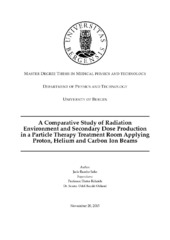| dc.description.abstract | A treatment room used for radiotherapy is generally heavily shielded and has to fulfil and abide to strict rules and regulations in order to ensure the safety and health of hospital personnel and the general public that find themselves in the vicinity of the treatment room during beam time. Secondary particles, especially neutrons and photons due to their neutral property and induction rate, can carry and deposit energy a significant distance away from their initial production site and potentially cause unintended damage and adverse effects in living tissue and materials. Neutrons and photons are induced when energetic particles interact and collide with matter, and in a radiotherapy treatment setting occurs not only in beam components (degrader, collimator, etc.) that are introduced into the beam line, but also in the patient and surrounding shielding. Fixed beam scanning therapy has the advantage of requiring a minimal number of beam components in the beam line and thus contain the main induction of secondary particles to the patient and surrounding geometries. In this thesis a basic treatment room with realistic dimensions modelled after a fixed beam scanning system facility, and a water phantom functioning as a substitute patient, was implemented in the Monte Carlo simulation package FLUKA, and the geometry created using the flair - FLUKA Advanced Interface. The beam placement, thickness and placement of main treatment walls, size and location of water phantom and the treatment volume were all kept constant and consistent in all simulations when applied. All results were further processed and normalised to a single fractional delivery of 2Gy in the treatment volume. The purpose of this master thesis has been to perform a comparative study of the induced radiation environment inside a typical treatment room during irradiation of a water phantom with proton, helium and carbon beams, and introduce various entrance structures and shielding materials to the treatment room in order to compare and illuminate their effects and study the differential fluence spectra of neutrons and photons entering and exiting these featured structures. Water equivalent worker phantoms representing hospital personnel were placed inside and outside the vicinity of the entrance structures and effective dose to each of them were scored. A total of 24 simulations covering eight different treatment room layouts were performed in FLUKA and the final results illuminated the many considerations and deliberations that must be taken into account during the planning, building and shielding fitting of a treatment room for use in particle therapy. | en_US |
